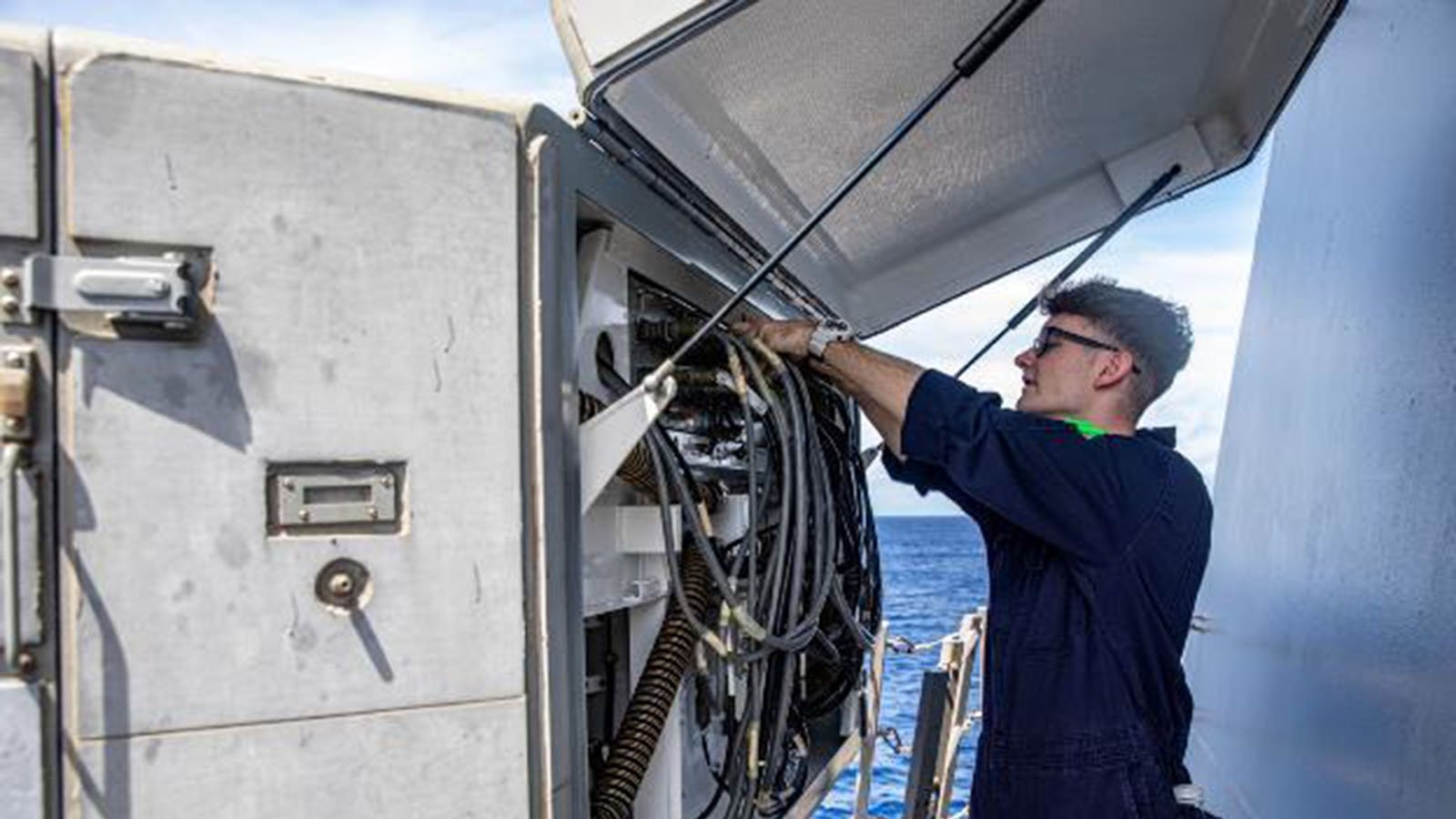
Cryptologic Technician Technical 2nd Class Ryan Smith, from Cave Creek, Ariz., conducts maintenance on an SLQ-32 electronic warfare suite aboard the Arleigh Burke-class guided-missile destroyer USS Halsey (DDG 97). (U.S. Navy photo by Mass Communication Specialist 3rd Class Jaimar Carson Bondurant)
WASHINGTON: The electronic warfare capability scheduled for installation onboard several classes of Navy warships experienced multiple problems while in use on an aircraft carrier during testing in April 2021, leading Pentagon weapons testers to doubt whether it will meet key performance goals.
The capability, part of the Surface Electronic Warfare Improvement Program (SEWIP) Block 2, is planned for outfitting on Navy aircraft carriers and destroyers. But testing last year on the aircraft carrier Gerald Ford (CVN-78) showed the system reporting “extraneous contacts for the radio frequency emitters it detects” and misidentifying “non-radio frequency emissions as [anti-ship cruise missiles],” according to the Pentagon’s chief weapons tester.
The specific issues experienced onboard the carrier were excluded from the annual testing report published by the Pentagon in January, but the issues were described in a different version of the same document labeled as “controlled unclassified information” and made public by the Project on Government Oversight.
Joe Ottaviano, an executive at Lockheed Martin, the prime contractor delivering the block 2 version of the system to the Navy, said in a statement to Breaking Defense that the issues raised in the Pentagon’s report were already known to the company. “As part of an ongoing engineering services contract for SEWIP Block II, we routinely assess the system’s functionality and performance so that we can proactively find, fix and improve the system before problems arise,” he said.
“The DOT&E report highlights several findings that we are aware of and are working in close partnership with the Navy to address and have addressed these findings,” he continued.
As of press time, a Navy spokesman did not respond to questions from Breaking Defense for this report.
Fighting On The Electronic Seas
SEWIP is one of the Navy’s premiere electronic warfare capabilities programs and versions of its chief system are already on almost every surface ship in the fleet. Given the issues the new weapons tester reports brought to light and the Navy’s nascent plans to install the next block of SEWIP systems onto destroyers in the near future, Breaking Defense thought it was a good time to explain what SEWIP brings to the Navy’s fight. But first, what’s electronic warfare?
Electronic warfare, or what the Pentagon now more often calls the electromagnetic spectrum, uses electromagnetic or directed energy to accomplish one of three goals, according to Brian Hinkley, a retired Navy captain with more than two decades of experience as an electronic countermeasures officer: electromagnetic attack or jamming an adversary’s systems, defensive measures to protect personnel or protect equipment from getting jammed and electronic support which focuses on surveillance and identifying sources of electromagnetic energy.
SEWIP, then, is the Navy’s overarching program to incorporate various EW capabilities into its ships.
“SEWIP will give us better capability to sense the environment,” said Hinkley, who also serves in leadership positions with the Association of Old Crows, a non-profit organization focused on EW, and is an executive at the services provider Amentum. “It’ll give us a better capability to jam incoming missiles in the maritime domain.”
But SEWIP is also the source of some confusion for navy observers, as Capt. Jesse Mink, one of the officers overseeing SEWIP for the Navy, explained during his presentation at the Surface Navy Association’s annual symposium earlier this year.
“A lot of folks call it SEWIP… But I want to make sure you understand that SEWIP is the program. We don’t install SEWIP onboard ships,” he said. “We install versions of SLQ-32.”
AN/SLQ-32, often pronounced as “slick 32,” is the chief system the SEWIP program has incrementally upgraded since 2002. The program has subsequently been divided into blocks since its inception with a different prime contractor for each block.
RELATED: Why hasn’t Russia used its ‘full scope’ of electronic warfare?
The blocks are further divided to denote certain capability differences, but in general, Lockheed Martin is the prime contractor for block 2, the version cited in the weapons tester report, and Northrop Grumman is producing block 3, which will bring new electronic attack capabilities to the fleet. General Dynamics and Lockheed Martin have been the prime contractors for various iterations of the legacy block 1 SLQ-32. (There is also a “lite” versions of block 2, designed to be more modular.)
A fourth SEWIP block exists on paper but mostly serves as a bookmark for undetermined future upgrades the Navy will seek following its own research and development.
While SEWIP as a program has only been around since 2002, historically EW has proven itself to be a decisive capability during armed conflict. Some forms of communications jamming have been present in military operations going back for more than 100 years ago, Hinkley said.
“He who had the communications and had the ability to pass that information, whether it was to people or to weapon systems, that was the critical linkage. So anyone that could disrupt that linkage was given an advantage,” he said. In most every armed conflict “everybody proves time and again that you have to control the EMS for almost all military operations to be successful.”
Moving forward, the Navy is in the process of installing SLQ-32V(7) — the capability associated with SEWIP Block 3 — onboard a Flight IIA Arleigh Burke-class destroyer.
“This [SLQ-V(7)] is revolutionary in its ability to do electronic attack for surface warfare,” Mink, the Navy officer partly responsible for the SEWIP program, said. “We’ve never had this capability afloat before.”
In the meantime, though, it remains to be seen how the problems in block 2 may postpone the system from getting its final green light from the Pentagon’s development and test community.




















